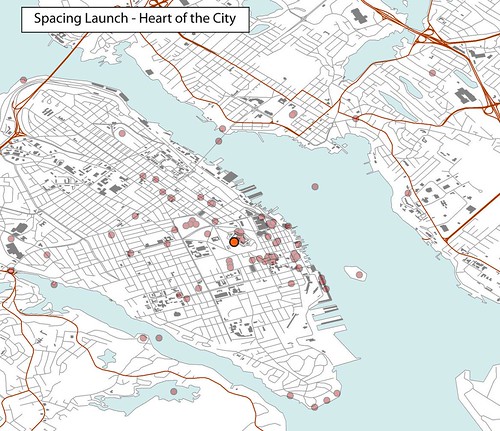At last week’s launch party the Spacing Atlantic street team gave guests the opportunity to identify their own personal “heart of the city” on a 3m x 3m map of the urban area surrounding Halifax harbor. Eighty two people in attendance took the opportunity to stick a sticker and rep the spot they felt best represented the cultural, social, commercial, or traditional centre of the city.
The spacing editors gave me a copy of the map earlier this week and I have taken the opportunity to perform a bit of basic analysis on the placements we all choose. As a refresher, here is the whole map as it looked at the end of the night (each red dot is a unique estimation of the heart of the city).
The visual clustering of heart choices provides some obvious insights at first glance; Spring Garden Road, Citadel Hill, the North and South Commons, and the Public Gardens hold strong through this exercise as landmarks of the city. In addition to these expected clusters the choices clustered around Marginal Road, the intersection of North and Robie, and around Gottingen Street provide some cursory evidence as to the success of the Seaport redevelopment and the growing profile of these neighbourhoods among those in attendance at the launch.
There is a secondary clustering that is missed by the analysis; the tendency for guests to choose locations for their heart of the city near (or even in) the ocean; the North West Arm, the Dingle, George’s Island, the MacDonald Bridge, and Point Pleasant Park all featured prominently in the choices of guests.
In an effort to provide a summary of the choices that were made I calculated at the geographic mean centre of the heart of the city. The result was comically unsurprising, see below (orange dot).
Fort George, at the top of Citadel Hill, was calculated to be the geographic centre of our choices for the heart of the city (the south-western side of the fort, to be exact).
The fact that this site appears at the centre of 82 unique individuals’ choices for the heart of the city is no doubt influenced by the raw geography of the peninsula, the traditional situation of landmarks in reference to the defensive position (Fort George), and the fact that this was almost the exact geographic ground breaking of British settlement in the Halifax region. These factors (and others) have influenced the way the city has developed since inception and, in turn, how the resultant built form and landmarks of the city influenced each of the attendees at the launch party.
I am not suggesting here that this siting of the average “heart” was predetermined or that it is definitive in any way whatsoever but I do think that this siting should make us think a little bit about the strength of heritage and history in Halifax, and how this strength continues to influence—consciously or not—the way we all experience our city in the present.
dots courtesy of the 82-plus guests at the Launch Party last Wednesday



5 comments
Loved the map… when I left, I was the only dot in Dartmouth. I put the “heart” there, too, at Five Corners… perhaps out of badness.
Great work Jacob; the result is comically entertaining. I kinda feel that the heart of Dartmouth is at Sullivan’s Pond: a block from 5 Corners, up from the waterfront near the downtown and Banook…
I have to admit that I took a ‘pin the tail on the donkey’ approach to finding the heart. the heart ended up in the harbour…
Psychogeographers would have a field day.
Maps are fun to play with, and I like this example.
Creative mapping is a really good exercise to undertake just to get a better feel for the city. Mapping where you walk, or where you’ve gotten drunk, or bank machines you take money out of, etc…